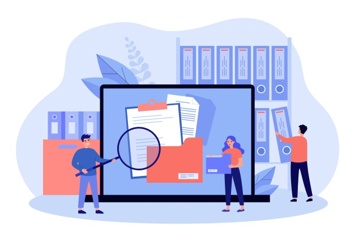4 Ways to Get More from Your eSourcing System
One of the most common issues organizations face once a business software investment has been rolled out is using it to its full potential. Once the system is embedded users tend to find their own way of working with it, with habits and preferences (good or bad) becoming woven into their working day. So, it’s always useful to get an outside view, and to take a step back to evaluate current usage and spot ways current process can be improved. It’s no different with eProcurement software.
With this in mind we’ve recently been offering free ‘Procurement Health Checks’ from our eProcurement specialist, Jurgita Andrijauskaite. Having led the global sourcing team at a £3bn global logistics business prior to joining Medius, Jurgita knows a thing or two about optimizing how eSourcing technology is used. Part of this Health Check process involved reviewing clients’ current use of their eSourcing system and making recommendations to help them get more out of it. From the Health Checks we’ve identified the 4 most common eSourcing user issues, and how we’d recommend addressing them.
1. Trust the cloud with your data
‘One central location’ is a classic buzz phrase thrown about with cloud business technology. The idea of managing and accessing information easily via a web interface appeals to those that have struggled tirelessly to locate everything relating to a project, or traipsed through system after system to find just one file. Yet we discovered some of our clients still manage some of their supplier information, related supplier documentation and contracts over separate network locations, rather than using their eSourcing software to collect and store it for them in the cloud, and in some cases missing the opportunity to pass it through to other connected procurement modules they have with us.
Recording supplier information locally also means that knowledge on suppliers is easily misplaced or not recorded in a consistent manner, and so when you go out to tender to a supplier you’ve previously dealt with, they may have to tell you information that you should already know. A Supplier Registration Form (SRF) for example allows you to capture the information your organization requires from all suppliers and thus makes it easier to go out to tender with suppliers you have already dealt with.
However, we found that sometimes users failed to properly set up their SRF and were not capturing the information they should be. So, when implementing a new eSourcing system it’s essential to get your SRF set up properly. Key stakeholders should discuss and agree upon all the information that you’d like to know about each potential supplier. You can then build the SRF in line with this and begin to accumulate knowledge on an array of suppliers. With this knowledge safely stored, going out to these suppliers will become easier and can help you and your suppliers save time. It also gives you a ready-made repository of supplier information.
2. Don’t be afraid of eAuctions!
With the functionality there to be used, we found that some of our clients didn’t use eAuctions to help drive value, even when there were clear opportunities to try it. Whilst eAuctions are not always appropriate, they can play a significant role in helping your organization get the best deal in the market. The issue we often see is that whilst clients see the value that eAuctions can bring, they hadn’t yet got around to testing the water.
Quite often the reluctance was around the effect on supplier relationships. Many believe that in playing different suppliers against each other in a war over price, it could see some suppliers feel undervalued for things such as the quality of their products or the service they deliver, straining any current relationships. Yet this isn’t reality. Suppliers have an appreciation of the need for them to be competitively priced to win business. It’s far from a new concept in business and suppliers will be fully aware of their customer’s need to drive value.
They’ll also be acutely aware that whilst buyers are using eAuctions to drive down price, their decision will not be made solely on who’s the cheapest, it’s just another piece in the puzzle. eAuctions also expedite decision making processes, and so by shortening timelines to awarding spend, all suppliers can benefit.
The best way to introduce an eAuction is to start with non-business critical items, to give stakeholders an opportunity to really get an understanding of how eAuctions work and just how effective they can be, and the insight on how the system can be used, and adapted, across more spend categories. Once a solid understanding has been formed, you can then begin to apply eAuctions to drive further savings in your supply chain.
There has to be a reality check of course, as the nature of running an eAuction means that it won’t be applicable for some spend. The key thing is to weigh up the extra savings benefits eAuctions can generate, against where the bidding dynamic wouldn’t suit the nature of the product or service in question, or the amount of due diligence required to find the right supplier. In the real world, and in the best procurement functions, there is a place for both eAuctions and eTenders.
3. Create a schedule
One theme we discovered was a lack of clear planning on what eSourcing auctions or tenders were due to be carried out in the future, and how these events were to be managed. This generally created a more reactive environment, providing little notice for staff to prepare to use the system. Procurement professionals are no different to anyone else, and if handed a project with a short deadline, were likely default to familiar old processes and avoid using the system, to ensure they hit their targets and deadlines.
When in a reactive cycle like this, it reduces the amount of exposure different users get, and perpetuates unfamiliarity, making it unrealistic to expect a 100% uptake. The solution is to create a sourcing event pipeline, combined with refresher training, even some practice runs, to get everyone within the team more prepared and more confident.
Of course, we know that many sourcing activities are landed with procurement on a reactive, ad-hoc basis, but by collating as much advance notice from the business and creating a schedule, detailing responsibilities and timelines is still the sensible way to go. In short, ensure old comfortable habits don’t prevail, and you’ll see more events going through the system.
4. Let automation help you
The final common eSourcing issue we found is that some clients were still manually assessing all their sourcing events, as opposed to using the evaluation functionality that’s available within eSourcing. This is a similar issue to the SRF issues, whereby it’s the initial setup that requires all the work, but from thereafter you can reap the rewards. Try setting up an automatic evaluation for one of your tenders and see how it can help save time and remove the potential for human error.
The best tenders to try are ones that ask for large amounts of quantitative information. You can set up rules to allows every tender response to use a scoring mechanism, ensuring consistency of evaluation and improving process transparency. This also frees up the time for those working on the tender, and allows them to make more informed decisions, yet again driving savings.
Once you’ve tried one this way, and you become familiar with how to set it up, it’s unlikely you’ll go back to manual evaluation, except for the more qualitative surveys that need more manual scrutiny. So, these are our top 4 most common eSourcing issues we discovered and how you can address them. At Medius we work hard to make sure our clients get the most out of their eProcurement software, and if you’d like to know more about how a healthy procurement system can help you, then please get in touch with us.






